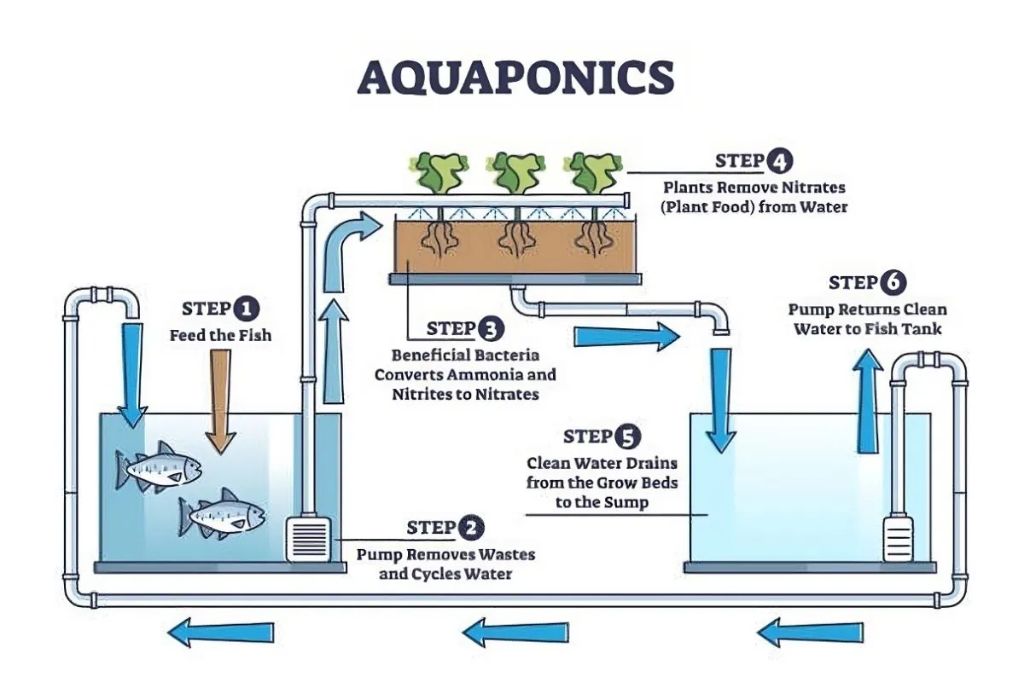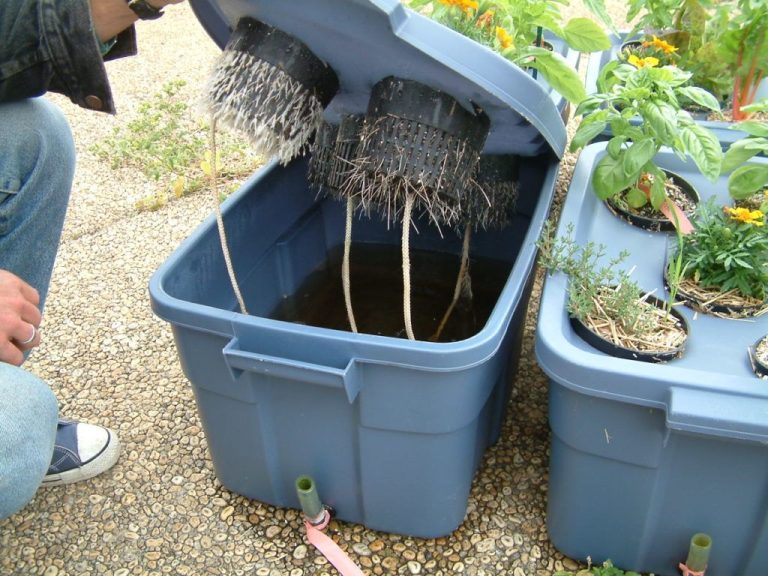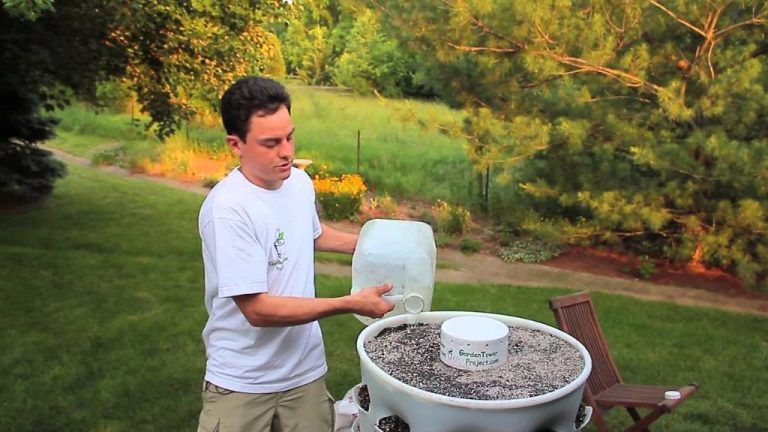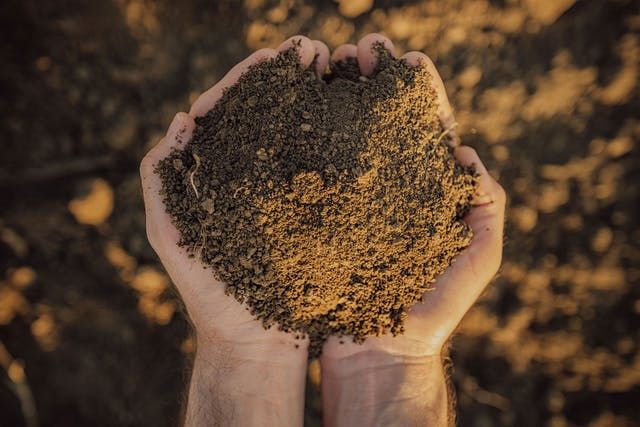Aquaponics: Combining Fish Farming With Edible Gardening
Aquaponics is the combination of aquaculture (fish farming) and hydroponics (soilless gardening) in one integrated system. In aquaponics, fish waste provides nutrients for the plants, and the plants filter the water for the fish in a sustainable ecosystem (Green Global Travel, 2022). The word “aquaponics” comes from “aqua” meaning water and “ponos” meaning labor (Aquaponic Gardening, 2011).
The earliest examples of aquaponics date back to ancient Mexico and rice farmers in Asia who cultivated plants and fish together in paddy fields over 1,000 years ago. Aztec chinampas systems in Mexico integrated plants, aquatic life, and wetland environments. In the 1970s, experimental research at the New Alchemy Institute and North Carolina State University explored aquaponics using fish tanks and gravel beds to grow food. Modern aquaponics began in the 1980s combining hydroponic plant beds with recirculating aquaculture systems. Today, aquaponics is used for sustainable food production in backyard home systems as well as large commercial greenhouses (Green Global Travel, 2022).
The benefits of aquaponics include efficient resource use, high yields, organic certified produce, reduced water usage, and symbiotic propagation of fish and plants. Aquaponics systems allow fish and plants to thrive together by recreating balanced natural ecosystems. Aquaponic gardening can take place year-round in any environment, leading to local food security and independence. From small urban farms to rural greenhouses, aquaponics provides an innovative approach to growing fish and vegetables together (Aquaponic Gardening, 2011).
How Aquaponics Works
Aquaponics is a combination of aquaculture (fish farming) and hydroponics (soil-less planting). It creates a symbiotic environment where the fish waste provides nutrients for the plants, and the plants naturally filter the water for the fish.
The main components of an aquaponics system are:
- Fish tank – Holds the fish and produces nutrient-rich waste.
- Settling basin – Collects the solid fish waste that sinks to the bottom.
- Mechanical and biological filtration – Converts the ammonia from fish waste into nitrates using beneficial bacteria.
- Hydroponic grow bed – The plants are grown without soil here, absorbing the nitrates from the water.
- Pump – Circulates the water from the fish tank through the system.
The process works through the nitrogen cycle. The fish waste produces ammonia. Nitrifying bacteria living in the filtration system convert this into nitrites, and then into nitrates. The nitrates act as food for the hydroponically grown plants. The cleansed water is returned to the fish tank, completing the cycle.
This creates a closed-loop system that recycles nutrients and water very efficiently. The plants act as natural biofilters, meaning no chemicals are needed and the fish stay healthy. It allows food production with minimal water usage and environmental impact compared to conventional gardening and aquaculture.
Fish Farming Aspect
The fish farming aspect of aquaponics involves raising fish in tanks and using their waste to fertilize the plants. Some of the most suitable fish species for home aquaponics systems include:
- Tilapia – Hardy, fast growing, tolerant of fluctuating water conditions (Source)
- Trout – Thrive in cooler water, high waste producers ( Source)
- Koi – Ornamental carp, very hardy, can withstand cold winters (Source)
The fish tank setup should allow for adequate swim space, water filtration, and dissolved oxygen levels. Fish are typically fed fish feed pellets 1-2 times per day. Maintaining optimal water quality involves monitoring ammonia, nitrites, pH and temperature and performing partial water changes when needed.
Hydroponic Gardening Aspect
The hydroponic aspect of aquaponics involves growing plants in a soilless medium. This allows the plant roots to access nutrient-rich water while getting support and oxygenation. Some of the most suitable plants for aquaponics include leafy greens like lettuce, spinach, kale, chard, and herbs like basil, mint, oregano, and thyme. Fruiting plants like tomatoes, peppers, cucumbers, and strawberries also thrive.
Plants are typically grown in grow beds filled with an inert medium like gravel, clay pellets, or coconut coir. The roots dangle into the water, absorbing nutrients while the grow medium provides stability and aeration. The best plants for aquaponics are ones that grow quickly and have high nutrient demands.

Instead of adding chemical fertilizers, aquaponic systems rely on fish waste and bacteria to naturally provide nutrients for the plants. As fish metabolize food and excrete waste, bacteria in the system convert ammonia from the waste first into nitrites, then into nitrates. The nitrates are absorbed by plant roots as food.
The Nitrifying Bacteria
Nitrifying bacteria play a critical role in aquaponics systems by converting ammonia from fish waste into nitrite and then into nitrate, which is usable by plants. The two main types of beneficial nitrifying bacteria are Nitrosomonas bacteria which convert ammonia to nitrite, and Nitrobacter bacteria which convert nitrite to nitrate (The Importance of Nitrifying Bacteria in Aquaponics Systems). Maintaining optimal conditions for these nitrifying bacteria is key for a healthy, balanced aquaponics system.
Nitrifying bacteria thrive in warm water temperatures between 77-86°F and at a pH between 7.0-8.5. Adequate aeration and surface area in the grow bed media provides the oxygen and spaces the bacteria need to colonize (Bacteria’s Role In Aquaponics). Careful monitoring and maintenance of these parameters allows the nitrifying bacteria to efficiently convert the ammonia from fish waste into nitrate nutrients that the plants can absorb.
System Maintenance
Proper maintenance is crucial for keeping an aquaponics system functioning optimally. Water quality testing should be conducted regularly to monitor levels of ammonia, nitrites, nitrates, pH, and dissolved oxygen. Ideally, ammonia and nitrite levels should be 0 ppm, nitrates less than 150 ppm, pH between 6.8-7.2, and dissolved oxygen at least 5 ppm.1
The system should be checked daily for any clogs or debris in the pipes, filters, and pumps. Clean filters as needed to maintain good water flow. Inspect plants and fish regularly for signs of stress or disease. Periodically prune dead leaves and roots from plants.
Some common issues to troubleshoot include:2
- Lack of water circulation due to clogged filters, insufficient pump power, improper plumbing, or air bubbles in pipes – Check all components and clear any obstructions.
- pH fluctuation – Use pH buffers as needed to maintain ideal range.
- Cloudy water – Can indicate bacterial bloom; treat water with UV sterilizer.
- Nutrient deficiencies in plants – Supplement chelated iron, calcium, potassium as required.
- Fish health issues – Look for signs of disease; use quarantine tank if needed.
With regular system checks and maintenance, aquaponics can function smoothly for many years.
Getting Started
Getting started with aquaponics requires careful planning and preparation. The first step is deciding on the system design and size to fit your space and production goals. Common system designs include media-filled beds, NFT (nutrient film technique), vertical towers, and raft systems. The size can range from small household systems to large commercial scale operations.
You’ll need equipment like fish tanks, hydroponic grow beds, plumbing and pumps, aeration, lighting, seedlings and fish fingerlings. The basic equipment for a small backyard system can cost $500-$2,000, while large commercial systems can cost $50,000-$500,000 (https://www.collilaw.com/aquaponics-startup-cost/).
Operating costs include electricity, fish food, system maintenance, testing supplies, and labor. Ongoing monitoring and fine-tuning is important for optimal plant growth and fish health. It’s advised to start small and simple when first getting into aquaponics.
Maximizing Efficiency
When designing and operating an aquaponics system, there are several factors to consider for maximizing efficiency and productivity:
For optimal plant growth, pay close attention to the pH and nutrient levels in the water. Test the water regularly and make adjustments as needed to maintain a pH between 6.8-7.0. Plants uptake nutrients best within this pH range. Also monitor ammonia, nitrites, and nitrates and keep them at recommended levels through biofiltration and water changes.
Maximize the growing space by using vertical towers, stacking grow beds, or training vining crops along strings or trellises. This allows more plants to be grown in a smaller footprint. Floating raft systems are also space-efficient as plants sit directly on the water surface.
Aim for energy efficiency by utilizing a gravity-fed water flow design if possible. This eliminates the need for pumps. Locate grow beds and fish tanks in greenhouses or outdoor areas that receive ample natural sunlight to reduce lighting needs. Insulate tanks and piping to retain heat. And grow plants that thrive in your ambient environment to minimize climate control requirements.
Other tips include starting seedlings in a nursery area then transferring them to grow beds to maximize space. And staggering plantings instead of growing large batches at once for a continuous harvest. With some strategic planning, an efficient aquaponics system can produce bountiful yields year-round.
Commercial Aquaponics
Large-scale aquaponic systems have gained popularity in recent years as a way to commercially produce both fish and plants. Commercial aquaponics leverages the symbiotic relationship between aquaculture and hydroponics to create an efficient closed-loop system.
Large-scale aquaponic systems require significant investments in infrastructure, equipment, maintenance, and labor. However, they can be highly profitable operations when designed and managed properly. The most common setup is a recirculating aquaculture system (RAS) combined with either a raft, NFT, or media bed hydroponic system to grow vegetables and herbs.
Some examples of successful commercial aquaponics operations include Superior Fresh in Wisconsin which produces 500,000 pounds of leafy greens and 225,000 pounds of Atlantic salmon annually, and Ouroboros Farms in California which sustainably raises tilapia and grows various lettuces in a 10,000 square foot greenhouse.
With proper business planning and aquaponic system design, commercial aquaponics can be a viable and eco-friendly business model for sustainably producing seafood and vegetables.
Future of Aquaponics
Aquaponics is growing rapidly as a sustainable method of food production. According to research from Energy5, “As the world population continues to grow rapidly and the demand for food increases, finding sustainable and eco-friendly methods of food production is becoming increasingly important.”
There are several key trends and innovations shaping the future growth of aquaponics:
- Increased adoption of aquaponics for commercial food production. Large-scale aquaponic farms are popping up around the world, producing fish and vegetables for local markets. Commercial aquaponics is expected to continue expanding as the technology matures. (Source)
- Advancements in system design and automation. New aquaponic system designs aim to maximize space utilization and production efficiency. Automated monitoring and control systems help manage critical parameters like temperature, pH, and dissolved oxygen.
- Integration of aquaponics with other technologies like hydroponics, renewable energy, and AI/IoT. Multi-loop systems combine aquaculture and hydroponics in creative layouts. Solar panels and wind turbines can offset the electricity usage of pumps and aerators. AI and internet-connected sensors enable remote system control and real-time data logging.
- Growth in areas unsuitable for conventional agriculture. Aquaponics only requires a small amount of space and water to operate. Facilities can be built almost anywhere – cities, deserts, cold climates, etc. This allows food production in non-traditional spaces. (Source)
With all of these innovations, aquaponics is poised for rapid growth in the coming years and decades. According to one study, the global aquaponics market is projected to grow at an annual rate of 7.4% from 2020 to 2027. As technology develops further, aquaponics could transform into a major pillar of sustainable food production worldwide.






